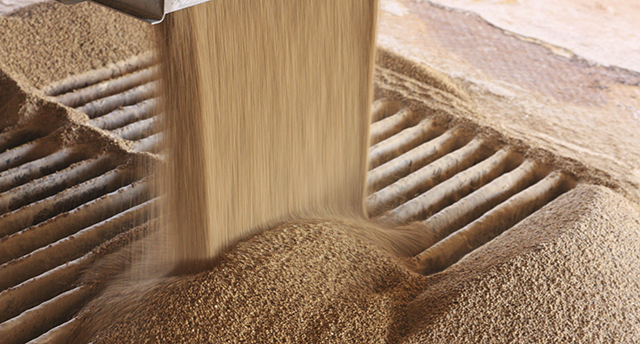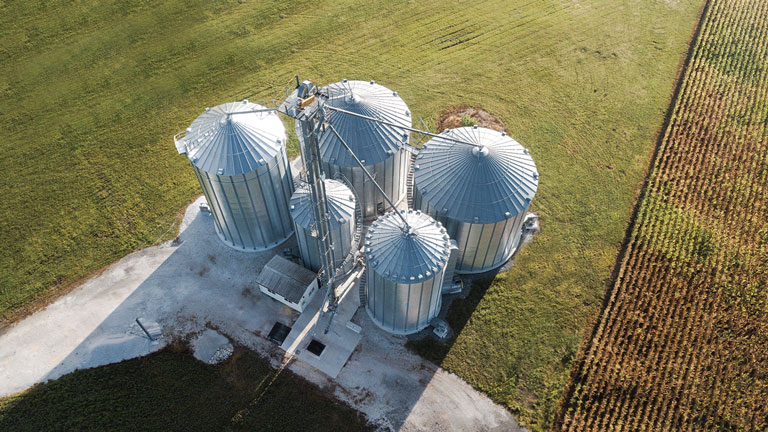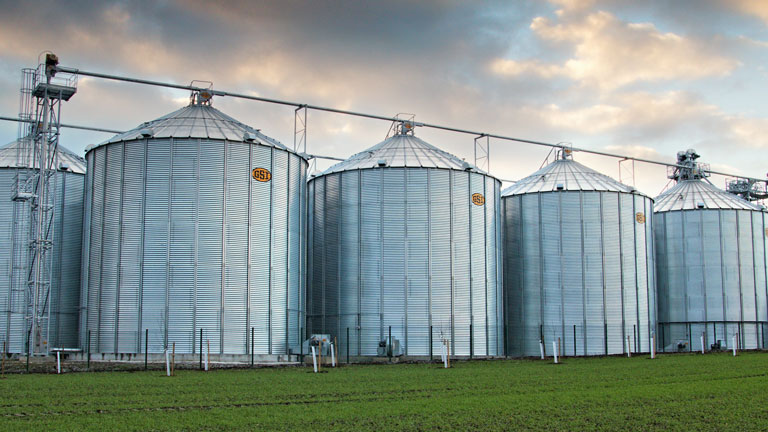
Additional Markets
In addition to grain and feed markets, InterSystems, the brand known as a worldwide manufacturer of bulk material handling equipment and industrial sampling systems, is found on a full range of products in support of other industries.

Sales and Service
Check this area often for updated manuals, software updates and limited time offers.

Resources
Learn more about GSI products and specifications in our brochure library.

About Us
GSI supports agriculture around the globe with the most extensive global manufacturing footprint and dealer network in our industry. We bring our customers local solutions with global expertise.
Seasonal Tips
PRE-HARVEST PREPARATION & BASIC FILL TIPS FOR GRAIN BINS
- Mow and remove all weeds and debris for safety and to remove safe harbors for vermin.
- Using proper respiratory protection, sweep and clean the interior of the bin. Pay special attention to cracks and any areas, such as inside stiffeners and obstructions, that may contain insects or mold-harboring debris.
- Following all instructions and using proper respiratory and safety equipment, Spray and treat the exterior and the interior of the bin, including under a full or partial floor, to minimize insect infestations and mold. Every few years check for accumulations under the floor and clean there, even if that means taking up the floor.
- Using proper respiratory protection, inspect and clean all passive or powered roof vents to ensure free flow of aeration or ventilation air.
- Inspect for leaks, rusting, or other deterioration of the structure of the bin to make sure it is structurally correct and repair any issues found.
- Check the condition of the bottom ring seal and repair if necessary to keep water from entering the bottom of the bin.
- Check the condition of the aeration fan, transition, and entrance color for damage and proper seal.
- If your system includes a drying bin, carefully check the gas supply lines, burner, vaporizer and burner gas train for leaks and make sure all are clean and free of debris, particularly the burner gun or exit. Have a qualified service technician repair any problems found. Make sure any rubber hoses are in good condition and replace them every 10 years or according to local gas ordinances.
- Inspect the entrance door making sure it is mechanically sound and shuts and seals tightly. Make sure these doors are correctly closed before you start to load the bin.
- When loading the bin, practice multiple coring to promote proper aeration of all the grain.
- Do not overfill the grain; this can put stress on the structure and may prevent proper ventilation through the roof vents.
- As soon as possible, pull the center of the bin down to the same depth as at the wall to promote center aeration.
- If leaving the grain cold, make sure the aeration fans and discharge augers are bagged off to prevent warm wet air from entering the bin. Do not keep cold grain past June 1st.
- Always practice proper safety with respiratory equipment as well as fall protection when working around any grain bin.
* Before performing any work or service, de-energize (turn off) and disconnect, lockout and tag, or block off all mechanical, electrical, hydraulic and pneumatic equipment that presents a danger, particularly grain-moving equipment. Grain should not be emptied or moved into or out of the bin while workers are inside.
PRE-HARVEST TIPS FOR HIGH CAPACITY GRAIN DRYERS*
- Using proper respiratory and fall protection, clean the dryers’ exterior and interior to remove all debris which may block airflow or affect operation. Low or high-pressure water can be helpful, but stay away from electrical boxes and controls. Lightly lubricate any areas prone to high wear or rust after this type of cleaning; be sure to do so before continuing with the suggestions below.
- Using proper respiratory protection, carefully clean the control boxes. Soft brushes, a vacuum, and/or compressed air will help you do a thorough and complete cleaning. Use a cloth to wipe down the interior as the final step.
- Inspect the electrical components for indication of overheating or physical damage that might affect operation and have them immediately repaired by a qualified service technician if necessary.
- Check all electrical connections to make sure they are tight to prevent operational issues and or damage from overheating. A systematic tightening at first startup and a retightening every 10 years thereafter will help maintain proper operation.
- Carefully check the gas supply lines, burner, vaporizer, and burner gas train for leaks and make sure all are clean and free of debris, particularly the burner gun or exit area. Have a qualified service technician repair any problems found. Make sure any rubber hoses are in good condition and replace every 10 years or according to local gas ordinances.
- Inspect all motors and ensure that they are securely fastened in place; lubricate bearings if applicable, but be careful to not over lubricate.
- Check all belts to make sure they are in good shape, properly tensioned, and that all safety shields are present.
- Inspect all ladder and platforms to ensure that they are safe to use.
- Lubricate any bearings that are not permanently sealed. Oil wood-type bearings if present. Inspect for condition and replace if necessary.
- Lubricate all chains and check for proper tension replacing if in disrepair.
- Check any gearbox for oil level and change out the oil according to the dryer’s maintenance schedule.
- Always practice proper safety with respiratory equipment and fall protection when working around any grain dryer.
* Before performing any work or service, de-energize (turn off) and disconnect, lockout and tag, or block off all mechanical, electrical, hydraulic and pneumatic equipment that presents a danger, particularly grain-moving equipment.
POST-SEASON DRYER MAINTENANCE
- Make sure you disconnect all power and turn off the gas supply before proceeding with any post-season maintenance!
- Just because you are done harvesting and drying your crop does not necessarily mean the job is finished. Before the cold winter weather sets in is the preferable time to perform that post-season cleanup around your grain drying system. Pay special attention to your grain dryer. Open all accessible doors such as outside metering roll access doors, two-foot bottom auger cleanout doors and inside plenum access doors. Completely clean out all remaining material either with pressurized air or a high pressure sprayer to eliminate foreign material from degrading augers, auger troughs and metering rolls of your dryer. After sufficiently cleaning these areas, leave these access doors open during the non-drying season.
- TIP: Do not forget to close these access doors before next year's use!
- Inspect power and control panel boxes for accumulation of bees wings and insect infestation. Utilize your vacuum system provided with Farm Fans PGC pneumatic cleaner or carry the old "shop vac" out to the dryer site and vacuum these areas. While you are cleaning, be aware of any possible areas that may allow rain, snow or even birds to get into these boxes and make any necessary repairs.
- Inspect burner ignition wires, flame detection wires, and control and power panel wiring for deterioration and replace if necessary. Also, take time to inspect all wiring connections that might have loosened during the drying season and tighten.
- Visually inspect bearings to see if there is any indication of one needing replaced and make a note to replace ones that are suspicious. Do the same with any drive belts and chains and lubricate those chains for the winter.
- Walk around your grain dryer system with your "Things To Do" notepad and make reminders of what needs to be looked at by your grain handling equipment dealer and get an appointment with him early for needed repairs or replacements.
- Remember, post-season maintenance helps prevent pre-season replacement. An ounce of prevention can save you tons of problems next year!
